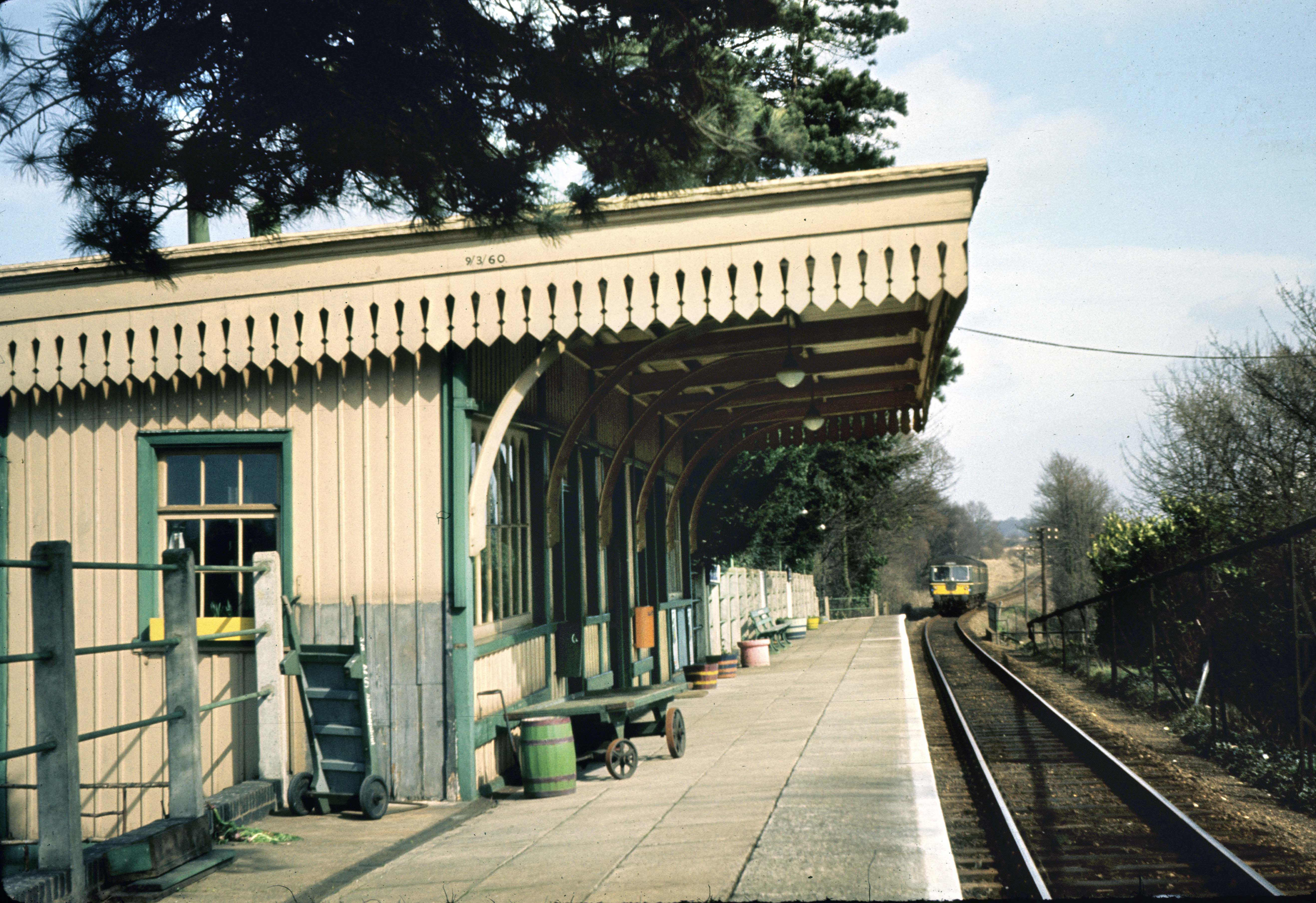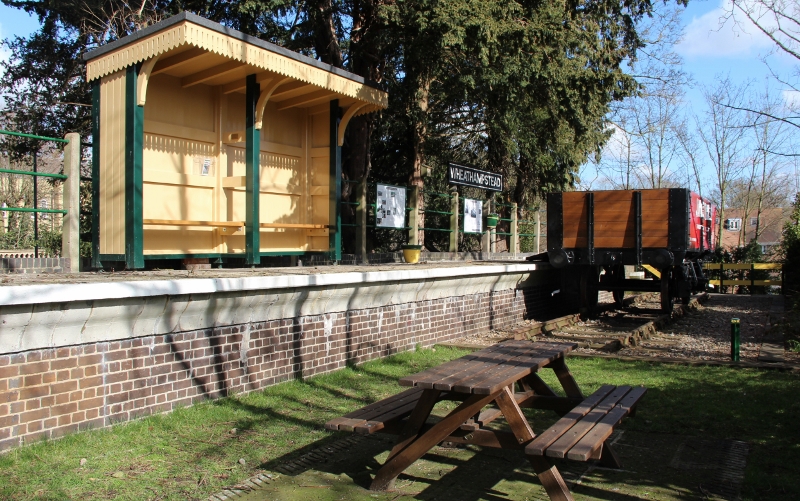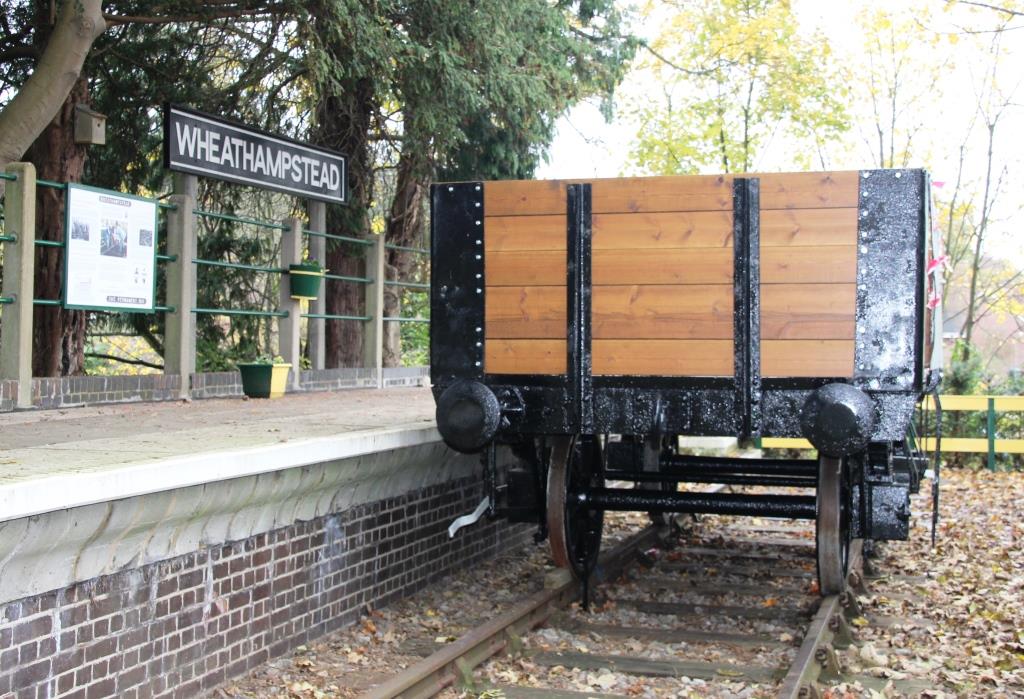Wheathampstead Heritage: Virtual Museum Exhibit
Main Description: Click to expand/contract
Wheathampstead Station was opened in 1860 on the new line that ran between Hatfield and Dunstable as part of the Hatfield to Luton and Dunstable Railway. For over 100 years it was the lifeblood of the village. Straw was sent from here to Luton for the hat trade, watercress was despatched to London, washing arrived from London along with elephant dung from London Zoo for local vegetable-growers. Live cattle were transported, pleasure trips to Norfolk started from here, fresh fish came from the coast, and visitors arrived for the fishing and golf. George Bernard Shaw, who lived in nearby Ayot St Lawrence, was its most famous passenger and sometimes cycled to the station.
The sidings and goods yard were on the far side of Station Road; the bridge across the road was demolished in August 1967. The station was closed to passengers in 1965 and to freight in 1967. The platform is being restored by a group of local volunteers, sponsored by the Parish Council.
During the construction of the station a rare seventh century bronze ewer was found; originally from the eastern Mediterranean, it is now in the British Museum. In 1884/85 at least one rich Anglo-Saxon inhumation burial was found near the station, including several human skulls. A cast bronze 'Frankish Alemannic' closed vessel (sixth or seventh century) and a glass palm cup were also recovered.
A Brief History
%20jpg%20lr(1).jpg) When the section of the Luton and Dunstable Railway was opened for both goods and passengers in 1860 villagers held a fete in Rectory Meadow. The innkeeper of The Swan supplied (at a moderate price) dinner and refreshments and there were sports and amusements. Music was provided by the brass band of the Herts Yeomanry.
When the section of the Luton and Dunstable Railway was opened for both goods and passengers in 1860 villagers held a fete in Rectory Meadow. The innkeeper of The Swan supplied (at a moderate price) dinner and refreshments and there were sports and amusements. Music was provided by the brass band of the Herts Yeomanry.
In the early days when the train was still a novelty, people would walk to Ayot Station for a ride back to Wheathampstead - just "to say they'd done it". In later years Mr Lee the station master organised Sunday School treats with a train leaving Wheathampstead at around 5am for Yarmouth, arriving there at noon and returning that evening.
On the 23rd January 1875 there was an "alarming accident" reported in the press when a train leaving Wheathampstead collided with a coal train. The accident occurred as the line rises steeply (for a railway) near a bend out towards Ayot. The goods train was unable to pull its heavy load up the incline and had reversed back to have a second attempt. In doing so it ran over the warning signal the driver had placed on the line to warn oncoming trains. A passenger train rounding the bend at full steam had thus been unaware of the problem and ran into the back of the coal train. The driver of the passenger train managed to jump clear but the fireman couldn't escape as the engine left the track and rolled over several times and down an embankment. Terence Pankhurst, one of the leading members of the station's restoration team, is the great-great-grandson of the passenger train's driver who lived to tell the tale.
The line brought business to Wheathampstead as well as pleasure bringing both people and products to the village. Local boys would waylay the well-off gentlemen who came to play golf at Gustard Wood hoping to caddy for them and earn a "few bob". Wheathampstead was quite a little resort - people also came to fish at The Fisheries along the Lower Luton Road and to visit significant families such as the Garrards at Lamer, the Shaws at Ayot St Lawrence and Earl Cavan at Wheathampstead House.
The Dyke Nurseries and those at Gustard Wood dispatched fresh salad to London and in return received elephant dung from London Zoo. The residents in Rose Lane lived close to the goods sidings and would frequently complain of the smell. The village also suffered with smells coming from Blackbridge tip which prompted George Bernard Shaw to liken it to "Stromboli and hell". Despite Shaw not being very complimentary about our station, the station master would often hold a train for him if he was running late.
Apart from farming and general goods, the railway also supported our local industry. Murphy Chemicals opened in 1932 and, amongst other things, produced chemicals for the war effort. The company called Smart's used the railway for shipping local gravel.
In-depth Description: Click to expand/contract
Closure and Restoration
 Wheathampstead Railway Station was closed to passenger traffic following the Beeching Report on 26th April, 1965. It remained open for freight until the 26th July 1967. The tracks, surrounding embankments and station buildings were all removed to make way for new developments and road improvements, As with many rural villages, the station had transformed the lives of local residents but within a few years of closure the station was all but forgotten.
Wheathampstead Railway Station was closed to passenger traffic following the Beeching Report on 26th April, 1965. It remained open for freight until the 26th July 1967. The tracks, surrounding embankments and station buildings were all removed to make way for new developments and road improvements, As with many rural villages, the station had transformed the lives of local residents but within a few years of closure the station was all but forgotten.
All that was left was most of the platform, high and dry on an isolated embankment raised four metres above the surrounding roads and buildings. Despite being within a stone's throw of the village centre, there it lay for over 40 years forgotten and completely hidden by ivy and saplings. In 2009 a group studying the heritage of the village rediscovered the platform remains and decided to restore it in time for the 150th anniversary of its opening on September 1st, 1860.
This was an ambitious project. The only access was by scrambling up the steep embankment. The tracks, platform slabs, ballast and all other signs of the railway had been salvaged or scavenged at the time of closure. All that remained were the railings, basic platform structure and some of the large edging slabs. Without access for heavy machinery or even water and power, the task seemed hopeless.
Undaunted, the team raised financial support from businesses, the Parish Council (who own the land) and other groups. Most importantly, all the work had to be done by hand (just as it was when the platform was built) so they had to rely on many villagers giving up their free time to clear the site. Wheathampstead is part of St Albans District and a group of sailors from HMS St Albans were dispatched to help (photograph).
By the time of the 150th anniversary of the opening in September 2010, the platform was once again open to the general public.
Original materials have been reused where possible on the platform but 14 new concrete edging slabs, each weighing a quarter of a ton, had to be made by hand. A member of the volunteer group made a mould and the slabs, each 42 inches by 36 inches by 4 inches, were cast in situ. All the materials (weighing several tons) had to be carried up to the site and the concrete was mixed by hand. One slab was cast each week for 14 weeks. A village resident donated flag stones for the surface.
Work has continued since then and a 40 foot section of the original track donated by Bam Nuttall has been put in place. This track is part of the original line and was lifted from a section near Dunstable during that section's conversion to a busway in 2011 and adds an authentic feel to the site. A recent visitor described visiting the platform as like visiting a film set.
The whole 120 foot platform is now complete with signage and access steps, and visitors can see a section of the original Victorian structure uncovered during the work.
With a section of track in place the next obvious move was to put some railway rolling stock on it. Conscious of security problems, the team opted to install an open goods wagon, the track being long enough to take it.
Over the winter of 2012/13 the team identified a suitable Great Western Railways wagon located at Cheltenham Race Course Station on the restored Gloucestershire Warwickshire Railway. The wagon was in a delapidated state but was transported to the site and has been carefully restored.
A small Heritage Lottery Fund grant was also secured to recreate a shelter on the platform in the style of the original waiting room. Both the wagon and shelter are now installed on the site.

See also Disused Railway Stations.
Additional Files: Click to expand/contract
| Main Interpretation Panel | /uploadedfiles/Main Panel 2014 Final.pdf |
| Interpretation Panel on People | /uploadedfiles/People 2014 Final.pdf |
| Contemporary report on railway accident 1875 | /uploadedfiles/Railway Accident 1875.pdf |
| Interpretation Panel for the Wagon | /uploadedfiles/Wagon Panel.pdf |
| The Permanent Way Information Panel | Permanent Way Information Panel.pdf |
Date Created: 01/01/2012 01:01:01, by: Adam Date last edited: 08/03/2015 16:29:56, by: David
